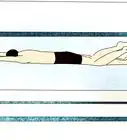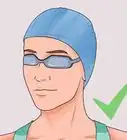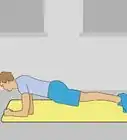This article was co-authored by Hayley Church and by wikiHow staff writer, Amber Crain. Hayley Church is an owner at Cooksey's Lifeguard & Swim Academy, LLC in Southern California. Hayley has been a lifeguard and swim instructor since 2007 and has dedicated her time to teaching people of all ages how to swim. Hayley and her team offer lifeguards and programming such as swim camp counselors, swim lessons, and water aerobics classes to clients of all sizes from large organizations to private homes. She received her Master’s degree in Recreation Management.
wikiHow marks an article as reader-approved once it receives enough positive feedback. In this case, 100% of readers who voted found the article helpful, earning it our reader-approved status.
This article has been viewed 373,384 times.
Learning the flip turn is essential if you want to take your swimming to the next level. Even if you only swim casually, perfecting your flip turn can help you settle into the rhythm of your laps and provide a burst of power and energy at each turn!
Steps
Approaching the Wall and Starting the Flip
-
1Start your turn when you see the black T on the pool floor. There is a black line at the bottom of your pool lane. The perpendicular line lets you know that the wall is two feet away. You can use the black T to let yourself know it's time to start executing your turn.[1]
- This can be hard to judge because it all depends on the length of your legs. Depending on how long your legs are, you would normally do two strokes after the T, then do your turn. If you're very tall or on the short side, adjust accordingly.
-
2Follow the last stroke of your arm under the water. As your arm enters the water, tuck your chin and keep kicking your legs to propel you over. Bring in both arms and position your hands at your sides.[2]
- Do not start rotating your body during this step.
- As you start to somersault, breath out hard through your nose to prevent any water getting up it.
Advertisement -
3Tuck your knees and feet as you angle forward to somersault. Keep your elbows close to your body. Make sure your knees are close to your chest. If you don't tuck your knees close enough, your feet will take too long to get to the wall.[3]
- The tighter you tuck your body, the faster your somersault will be.
-
4Unfold your upper body. After completing the somersault, release your elbows and extend your arms in the direction you just came from. Put your hands together. Your body should form a straight line from your torso to the tips of your fingers.[4]
- At this point, your legs are still tucked.
- Make sure you are not rotating in the water back onto your belly. You should be on your back at this point.
Completing the Flip and Pushing Off
-
1Untuck your legs and press your feet flat on the wall. Your toes should be pointing upwards, towards the top of the water. Your knees should be at 90 degree angles. Your hips need to be at about 110 degrees.[5]
-
2Straighten your legs as you push yourself off the wall. When your feet are flat against the wall, use them to push off. Your body should shoot off the wall like a torpedo. The harder you push off, the faster you will spring off the wall.
- Think of the flip as a jump. The more power you put into that push, the farther you're you'll go without having to put in work and start swimming.
-
3Rotate onto your stomach. As you are pushing off the wall, start rotating so that your back is facing the ceiling. Your belly will be facing down at the pool floor. Twist your hands and look towards the direction you want to twist. Don't move your head.[6]
- After kicking off and during rotation, you can perform a few strong dolphin kicks. This is optional, and may be something you want to do after you get better.
-
4Resurface and begin swimming normally. Swim around 10 to 15 feet ( approximately 5 meters) underwater using the butterfly kick in streamline position. Start the pull with the arm that was closest to the bottom as you rotated. Your hand should exit the water as you finish the pull. Now resume your freestyle stroke.[7]
Practicing the Flip Turn
-
1Learn how to somersault in water. Knowing how to somersault in water is essential for learning the flip turn. If you have never tried one, you should practice basic somersault technique. You want to be able to approach the wall, tuck your chin and fold into a ball, and start to flip over with your bottom popping out of the water as your flip over onto your back.[8]
-
2Practice each step of the technique separately. This technique requires a lot of practice. You need to practice approaching the wall and getting used to knowing when to breathe, where the correct length is for your height, and how to kick off and rotate in the water. Practice over and over, moving at a slow pace. As you get used to it, you can do it faster.[9]
- It is important that you don't speed up as you approach the wall until you master this flip. Otherwise, you could hit the wall and hurt yourself.
-
3Practice several times per week. The exact frequency is up to you, but perfecting this move will take some time. Practice as often as you can. Don't forget to take days off occasionally to rest up, though!
Community Q&A
-
QuestionAfter the flip I end up in deep water and have to swim up, using too much air. What do I do?
 Isabella Jiwon MorenoCommunity AnswerTry to angle yourself up and do your break out (three dolphin kicks and two strokes) before you breathe so you don't use as much air. Also, try humming, that make the air last a bit longer.
Isabella Jiwon MorenoCommunity AnswerTry to angle yourself up and do your break out (three dolphin kicks and two strokes) before you breathe so you don't use as much air. Also, try humming, that make the air last a bit longer. -
QuestionWhat happens if water gets in your nose, and you suck all the water in, which makes it feel really weird?
 Community AnswerYou'll be just fine. Try blowing out when you flip so this doesn't happen.
Community AnswerYou'll be just fine. Try blowing out when you flip so this doesn't happen. -
QuestionFor 50 meters, do I need to do a flip turn?
 Bella.561Community AnswerOlympic-length pools are 50 meters, so you would not need to do a flip turn in a pool of that length. However, most pools are only 25 meters/yards, and in such a pool, you would need to do a flip turn.
Bella.561Community AnswerOlympic-length pools are 50 meters, so you would not need to do a flip turn in a pool of that length. However, most pools are only 25 meters/yards, and in such a pool, you would need to do a flip turn.
Warnings
- When first learning how to do flip turns, be careful that your feet do not flop over and land on the edge of the pool. Many swimmers experience this when first learning how to do flip turns. It can be quite painful.⧼thumbs_response⧽
- Make sure there's nobody swimming right behind you before you flip, or you'll crash into them when you push off the wall⧼thumbs_response⧽
Expert Interview
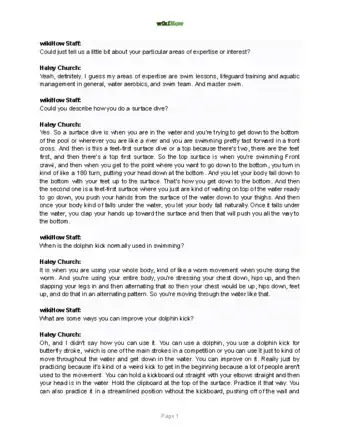
Thanks for reading our article! If you’d like to learn more about swimming styles, check out our in-depth interview with Hayley Church.
References
- ↑ http://www.active.com/swimming/articles/learn-to-master-the-flip-turn-877772?page=1
- ↑ http://www.active.com/swimming/articles/learn-to-master-the-flip-turn-877772?page=1
- ↑ https://swimswam.com/3-common-freestyle-flip-turn-mistakes/
- ↑ https://swimswam.com/3-common-freestyle-flip-turn-mistakes/
- ↑ https://www.thoughtco.com/freestyle-flip-turns-for-swimmers-3167905
- ↑ http://www.active.com/swimming/articles/learn-to-master-the-flip-turn-877772?page=1
- ↑ https://www.thoughtco.com/freestyle-flip-turns-for-swimmers-3167905
- ↑ http://www.active.com/swimming/articles/learn-to-master-the-flip-turn-877772?page=1
- ↑ https://www.thoughtco.com/freestyle-flip-turns-for-swimmers-3167905
About This Article
The best way to do a flip turn is to take 2 strokes past the black T on the pool floor, then shift your weight to tilt your body forward. Somersault by tucking your knees tight against your chest and your hands at your sides. To push off, keep your knees bent, extend your arms, press your feet against the wall with your belly facing up and spring off. Rotate until your belly is facing down, and continue swimming! For ways to make your flip turn faster and more powerful, read on!
-Step-1-Version-2.webp)
-Step-2-Version-2.webp)
-Step-3-Version-2.webp)
-Step-4-Version-2.webp)
-Step-5-Version-2.webp)
-Step-6-Version-2.webp)
-Step-7-Version-2.webp)
-Step-8-Version-2.webp)
-Step-9.webp)
-Step-10.webp)
-Step-11.webp)


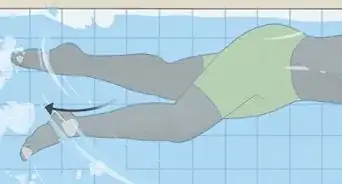


-Step-7-Version-2.webp)















